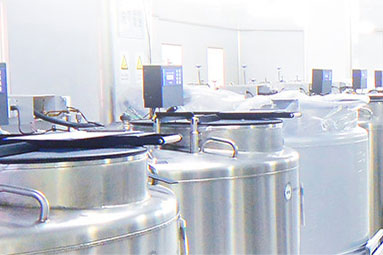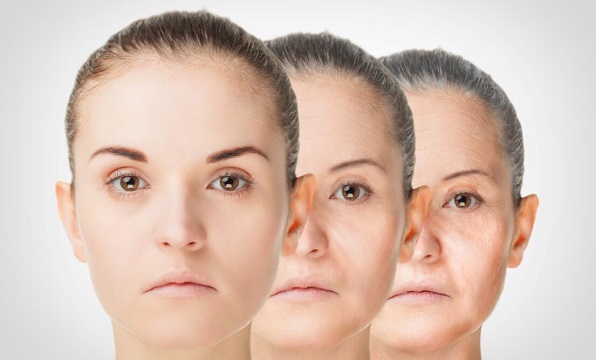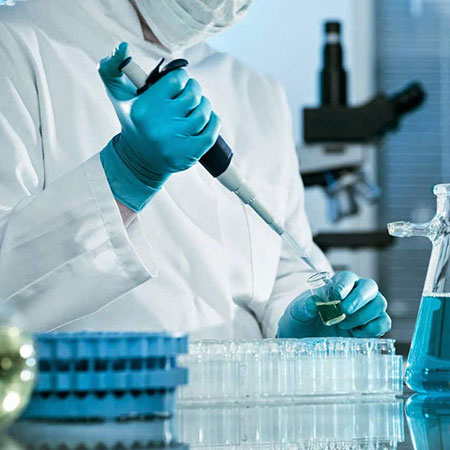- Email:[email protected]
- Tel: (852)51044851
-
Directed Conversion of Alzheimer’s Disease Patient Skin Fibroblasts into Functional Neurons
Liang Qiang, Ryousuke Fujita, Toru Yamashita, Sergio Angulo, Herve Rhinn, David Rhee, Claudia Doege, Lily Chau, Laetitia Aubry, William B. Vanti, Herman Moreno, Asa Abeliovich Directed conversion of mature human cells, as from fibroblasts to neurons, is of potential clinical utility for neurological disease modeling as well as cell therapeutics. Here, we describe the efficient generation of human-induced neuronal (hiN) cells from adult skin fibroblasts of unaffected individuals and Alzheimer’s patients, using virally transduced transcription regulators and extrinsic support factors. hiN cells from unaffected individuals display morphological, electrophysiological, and gene expression profiles that typify glutamatergic forebrain neurons and are competent to integrate functionally into the rodent CNS. hiN cells from familial Alzheimer disease (FAD) patients with presenilin-1 or -2 mutations exhibit altered processing and localization of amyloid precursor protein (APP) and increased production of Aβ, relative to the source patient fibroblasts or hiN cells from unaffected individuals. Together, our findings demonstrate directed conversion of human fibroblasts to a neuronalphenotype and reveal cell type-selective pathology in hiN cells derived from FAD patients.
[Read More] -
Stem cells responsible for ‘thinking’ brain cells identified
Scientists have identified a sub-type of stem cell responsible for neuron development within the cerebral cortex associated with higher-level brain function. A recent publication in the journal Science suggests these cells may have been important in the evolution of the human brain and could boost our understanding of advanced cognition in humans. Previously all cortical neurons were thought to originate from the same class of stem cells, known as radial glial cells (RGCs). However, the study revealed a distinct population of RGCs in mice embryos that gave rise to upper layer neurons in the outer region of the brain, which is where higher thinking functions are located. The upper layer is also believed to be the ‘newest’ in evolutionary terms. ‘Advanced functions like consciousness, thought, and creativity require a lot of different neuronal cell types and a central question has been how all this diversity is produced in the cortex’, said Dr Santos Franco of the Scripps Research Institute, California and first author of the paper. ‘Our study shows this diversity already exists in the progenitor cells’. The development process of upper layer neurons was traced in a specially engineered line of mice. A marker gene, Cux2, known to be expressed only by upper layer neurons, was linked to a series of genes which glow fluorescent red when activated. The scientists could monitor the cells expressing Cux2 under the microscope, observing that even at the earliest time point in embryonic brain development, the cells almost exclusively generated upper layer neurons. Meanwhile, the subgroup of RGCs not expressing Cux2 became lower layer neurons. The authors conclude that the specific fate of cortical neurons is pre-determined independent of birth date or location. Upper layer cortical neurons are especially abundant in the human brain and these stem cells could in future help provide treatments for disorders such as schizophrenia and autism. ‘This opens a door now to try to make these neurons, which are frequently affected in psychiatric disorders’, said Professor Ulrich Mueller who led the research team. But Professor Uta Frith of University College London’s Institute of Cognitive Neuroscience, told the New Scientist: ‘There is still a chasm between neuro-cognitive explanations of autistic symptoms and mechanisms in terms of cell structure. To put these two levels of explanation together is a big task’. Reference:http://www.bionews.org.uk/page_167457.asp
[Read More] -
How to make a veal of it
In 2008, the American animal rights organisation People for the Ethical Treatment of Animals (Peta) announced a US$1million reward to anyone who could use chicken cells to develop a marketable lab-grown meat by June this year. The contest deadline has been extended to January 1next year because no one has succeeded as yet. But scientists are getting closer to producing the first test tube chicken nugget. According to Peta, “some promising steps have been made towards this technology, but we’re still several years away from having in vitro meat being available to the general public”. Over the years there have been many attempts to create meat substitutes to please both vegans and animal rights activists. Many involve soy protein (such as Tofurky roasts and Soyrizo breakfast burritos) or wheat-gluten (such as Seitan gyros), or a combination of both. But Peta’s latest project is no meat substitute. We’re talking real meat and flesh, but produced in a lab, using animal stem cells placed in a medium to grow and reproduce. No killing involved. The Netherlands has beenleading the way in research. Stem cell scientist Dr Mark Post, from Maastricht University, expects to unveil the first-ever taste test of an in vitro hamburger next month – albeit at an expected initial price of ¤250,000 (HK$2.5 million). Some biologists warn that cell culture is expensive and technically difficult. But others believe costs will fall to mass-market prices once the technology becomes more common. Benjamin Wang, managing director of the Hongkong Stem Cell Centre, says: “In vitro meat could replace traditional meats in the future if it proves to be energy efficient. Specifically on a large scale, if we are committed to this research, I think it is very likely to be able to provide a new source of food.” Consuming lab-grown meat won’t have any more adverse effects on human health than real meat, according to Jason Matheny, founder of New Harvest, an organisation which is devoted to advancing technologies for new meat substitutes. Our goal is to develop a vegetable surrogate for meat that is both juicy and fibrous FLORIAN WILD, RESEARCHER, EU LIKEMEAT PROJECT “Cultured meat is made of the same stuff that real meat is made of. But in principle one could make it much healthier by controlling the amount and type of fat,” he says. In vitro meat is also more eco-friendly and less costly to produce than traditional…
[Read More] -
Inside Out – How stem cells can heal
Stem cells are part of the new age of medicine. Even if it had its beginnings centuries ago, today, because of advanced technology, its full potential can be powerfully and easily harnessed. What is the intrinsic nature of a stem cell? There are three types: Fertilized egg or germ cell. This has the potential to lead to the total and complete formation of an entire organism. Also referred to as Totipotent (all potential), it can become any cell type of the body. Pluripotent. This has the potential to become virtually any cell type except a germ cell. Embryonic stem cells (ESC) are traditionally called pluripotent stem cells. Multipotent. These are stem cells that are tissue specific, which have less self-renewal ability than the pluripotent variety. But this again is like going through the history of stem cells. This was the general thinking then. But now, medicine is changing in the way it views life. Why? Because recent studies have since shown strong evidence of something amazing. Adult stem cells (ASC) were once generally considered multipotent. But today, there is reason to believe that adult stem cells have pluripotent and totipotent capabilities. Therefore, is science expanding in knowledge, or is this proof that our bodies are evolving, adapting, surviving and even surpassing our own limitations? The breaking news is this: adult stem cells were identified that appear even more primitive or pluripotent than embryonic stem cells. Translation: A person’s very own stem cells can be harvested, stored and reintroduced into the body in strategic organs or tissues via injection. Another approach is to support the release of stem cells from the bone marrow. The use of adult stem cells transcends and bypasses all ethical boundaries facing embryonic stem cell research and approaches. ‘Stemness’ Is there a “stemness” of a cell? The answer is yes. This is the ability of a cell to divide through generations without losing its pluripotentiality. In short, a 50th-generation cell will be identical to the very first cell of the first generation. ESC has been studied for many years, but only in 1998 were ESC grown successfully in vitro. James Thomson succeeded where many had failed. For several years, he worked to develop a culture media for primate stem cells. He grew human ESC in a primate culture. But this spurred a series of questions. 1) Because ESC can become any cell type, could this be injected…
[Read More] -
Letter: Adult stem-cell research is future of science
The awarding of this year’s Nobel Prize in medicine to John Gurdon and Shinya Yamanaka for their pioneer adult stem-cell research has been held as both beautiful and ethical. This prestigious award should encourage institutions to switch funding from embryonic stem-cell research to adult stem-cell research which is more effective and without moral controversy. The awarding of the Nobel Prize in physiology or medicine to these two pioneers represents an important milestone in recognizing the superior potential of adult stem-cell research over the unethical, destructive experimentation on human embryonic stem-cells. In the past years, the attempts to clone human embryos and the bizarre experiments to create mixed human/non-human embryos have delivered nothing. In contrast, the transformation of adult stem-cells is making great progress. This is indeed science at its best: both beautiful and ethical. Both of these scientists were involved in research into changing mature cells into stem-cells which can be harvested in the potential treatment for a variety of diseases. This wonderful discovery stresses the key role that nonembryonic stem-cells play in the development of new medical therapies. The work of these two outstanding pioneer scientists should encourage government and institutions to switch funding from embryonic stem-cell research to adult stem-cell research. Since science serves human ends, not its own, scientific research must always respect the moral law. The dedicated research by these two scientists offers significant progress using adult stem-cells which is a sound moral alternative and offers better clinical results. Reference: http://www.reporternews.com/news/2012/nov/16/letter-adult-stem-cell-research-is-future-of/
[Read More] -
Smoking affects allergy-relevant stem cells
Leipzig. Environmental contaminants, such as smoking, are harmful to the human organism in relation to the occurrence of allergies. This is known. Until now, researchers had never investigated whether and to what extent environmental contaminants also affect allergy-relevant stem cells. For the first time a team at the Helmholtz Centre for Environmental Research (UFZ) has found evidence for this: Smoking affects the development of peripheral allergy-relevant stem cells in the blood. In order to present this result Dr. Irina Lehmann and Dr. Kristin Weiße chose a new scientific path: The combination of exposure analysis and stem cell research. Stem cells are not specialised, propagate without limit and can develop to different cell types. From these the different cell and tissue types of the human organism, including the allergy-promoting eosinophil granulocytes, are differentiated. Progenitor cells, e.g. eosinophil/basophilic progenitors, which mature in the bone marrow and are then washed out into the bloodstream – the so-called periphery – function as a link between unspecialised stem cells and specialised tissue and organ cells. Until now, whether and to what extent environmental contaminants affect this maturation and release has not been investigated. The UFZ team of Dr. Irina Lehmann and Dr. Kristin Weiße undertook their investigations from this point. Two facts were already known from a number of earlier studies: Firstly that the blood of allergy sufferers – whether children or adults – shows evidence of increased eosinophil/basophil progenitor levels. Secondly, that the occurrence of such peripheral progenitors in the blood of the umbilical cord indicates a higher risk for subsequent allergies. For the first time, the hypothesis which Dr. Kristin Weiße and Dr. Irina Lehmann developed on this basis combined this knowledge from stem cell research with the results of many years of exposure research at the UFZ. The researchers characterise their approach in the following way: “We wanted to clarify the relationship between environmental influences and the maturation and differentiation of the progenitor cells on the one hand and its contribution to the occurrence of allergies on the other hand. Specifically, we wanted to know whether the occurrence of allergy-relevant progenitor cells in the blood of infants can be changed by environmental influences”. The results of the study, based on the data collected from 60 children aged one year, were recently published in the British medical journal “Clinical & Experimental Allergy”: It was found that children with skin manifestations, such as atopic…
[Read More]
Category
Recent Updates
- Directed Conversion of Alzheimer’s Disease Patient Skin Fibroblasts into Functional Neurons
- Generation of human vascular smooth muscle subtypes provides insight into embryological origin–dependent disease susceptibility
- Stem cells responsible for ‘thinking’ brain cells identified
- Stem cell therapy combined with liposuction may help burns victims
- Kidney transplants better with stem cells
- Houston Plastic Surgeon Dr. Henry Mentz to Present Stem Cell Expertise at International Conference






SUBSCRIBE TO OUR NEWSLETTER